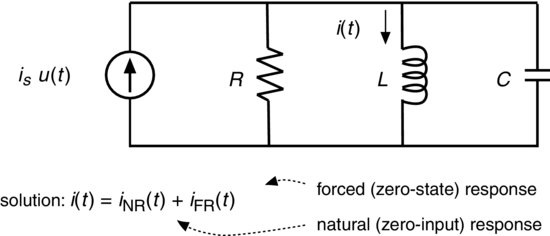7.7 DIFFERENTIAL EQUATIONS
Many systems in engineering are modeled by linear DEs with constant coefficients to describe how various quantities (signals, voltages, currents, and so on) change with time. For convenience in our discussion, we provide a simple example for a second-order RLC circuit.
FIGURE 7.17 Parallel RLC circuit. Current source is is switched on at t = 0 as indicated by the unit step-function u(t).

Example 7.22. A parallel RLC circuit (with resistor R, inductor L, and capacitor C) has an independent current source is that is switched on at time t = 0. The current through the inductor can be modeled by the following second-order DE:
where the coefficients {a0, a1, a2} are functions of {R, L, C} and u(t) is the unit-step function. A circuit diagram is provided in Figure 7.17 for which it can be shown
(7.157) ![]()
Depending on the coefficient values, the solution of (7.156) can take on one of three forms:
(7.159) ![]()
(7.160)
where and are functions of { ...
Get Probability, Random Variables, and Random Processes: Theory and Signal Processing Applications now with the O’Reilly learning platform.
O’Reilly members experience books, live events, courses curated by job role, and more from O’Reilly and nearly 200 top publishers.

